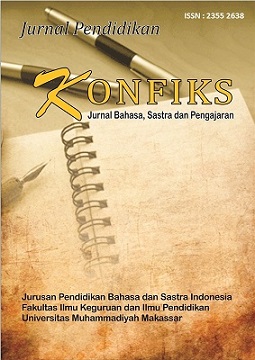PENGGUNAAN MEDIA SOSIAL BERBASIS PEMBELAJARAN BAHASA ASING HELLOTALK BAGI PENUTUR ASING (Kajian sintaksis)
DOI:
https://doi.org/10.26618/konfiks.v5i2.2112Abstract
HelloTalk be an alternative solution that is effective and efficient in learning SPEAKER because SPEAKER participants can apply the theory acquired in class. This study sheds light on when the SPEAKER in the learners chat rooms or through status-status of the written chat friends, revised the grammatical errors that tend to be confusing for the participants of the SPEAKER. This research aims to describe and explain the form of syntactic errors accompanied the form pembenarannya conducted by six informants, namely the account Charlesinoz (United States), HEEJAEPark (South Korea), Vince (Australia), Shachi. Chi (China), Sabri Sab (Pakistan), and Joseph (United Kingdom). This research uses qualitative descriptive approach. Data collection techniques used are tuned and note techniques. Data analysis was done by utilizing techniques in accordance in accordance with the method of referential, pragmatic, and match and read landmark. Results of the study concluded the form error fields syntax, i.e.: (1) raw and not structured sentences not bergramatikal, (2) the ambiguous sentence (3) sentences that are unclear, (4) the inappropriate diction in sentence form, (5) contamination of the sentence, (6) coherence, (7) the use of the word redundant, (8) loan words that are not exactly in the form of a sentence, and (9) the logic of the sentence. The research also shows most do mistakes, i.e. the use of the word is not raw or sentence is not grammatical. HEEJAEPark dominated with a total of 25 forms of error field syntax.
References
Corder. P. (1973). Introducing Applied Linguistics. Victoria: Penguin Education.
Ellis, R. (1994). The Study of Second Language Acquisition (Oxford: Oxford University Press, 1994), hlm. 302.
Iskandarwassid dan Dadang S. (2011). Strategi Pembelajaran Bahasa. Bandung: Rosda.
Richards,J., dkk. (1985). Longman Dictionary of Applied Linguistics. Inggris: Longman.
Jassem, A. (2000). Study on Second Language Learners of Arabic: An Error Analysis Approach. Kuala Lumpur: Pustaka Hayathi.
Kusmiatun, A., dkk. (2017). Need Assessment of Learning Materials of Indonesian for Academic Purposes for Speakers of Other Languages. Internatioal Refereed Research Journal, Vol 8 (3), hal. 151-159.
-------. (2015). Mengenal BIPA dan Pembelajarannya. Yogyakarta: K-Media.
Markhamah dan Atiqa S. (2014). Analisis Kesalahan dan Karakteristik Bentuk Pasif. Surakarta: Muhammadiyah University Press.
Markhamah. (2013). Ragam Dan Analisis Kalimat Bahasa Indonesia. Muhammadiyah University Press: Surakarta.
Muliastuti, L. (2017). Bahasa Indonesia Bagi Penutur Asing: Acuan Teori dan Pendekatan Pembelajaran. Jakarta: Pustaka Obor Indonesia.
Nugraheni, M. W. (2017). Media Sosial Berbasis Pembelajaran Bahasa Asing “HelloTalk” Sebagai Alternatif Media Belajar Bahasa Indonesia Bagi Peserta BIPA. Seminar Nasional KABASTRA II. Yogyakarta: Graha Cendekia.
Paltridge, B., & Starfield, S. (Eds.). (2013). The handbook of English for specific purposes. (e-book). Oxford: Wiley-Blackwell.
Ramlan, M. (2006). Sintaksis. Yogyakarta: CV Karyono.
Saadah, F. (2016). Analisis Kesalahan Berbahasa dan Peranannya dalam Pembelajaran Bahasa Asing. Wahana Akademika: Jurnal Studi Islam dan Sosial, 14(1), hal. 1-29.
Suyitno, I. (2004). Pengetahuan Dasar BIPA (Pandangan Teoritis Belajar Bahasa). Yogyakarta: Grafika Indah.
Downloads
Published
Issue
Section
License
Authors who publish with this journal agree to the following terms:
The author owns the copyright and grants the journal rights for first publication with the work simultaneously licensed under a Creative Commons Attribution License which allows others to share the work with acknowledgment of the work's authorship and initial publication in this journal.
Authors may enter into separate additional contractual agreements for the non-exclusive distribution of the published journal version of the work (for example, posting it to an institutional repository or publishing it in a book), with acknowledgment of its initial publication in this journal.
Authors are permitted and encouraged to post their work online (for example, in institutional repositories or on their websites) before and during the submission process, as this can lead to productive exchanges, as well as earlier and larger citations of published work (See The Effect of Open Access).
Statement of Authenticity and Manuscript Copyright can be downloaded: Here
After filling in the statement letter, please send via e-mail: konfiks@unismuh.ac.id

